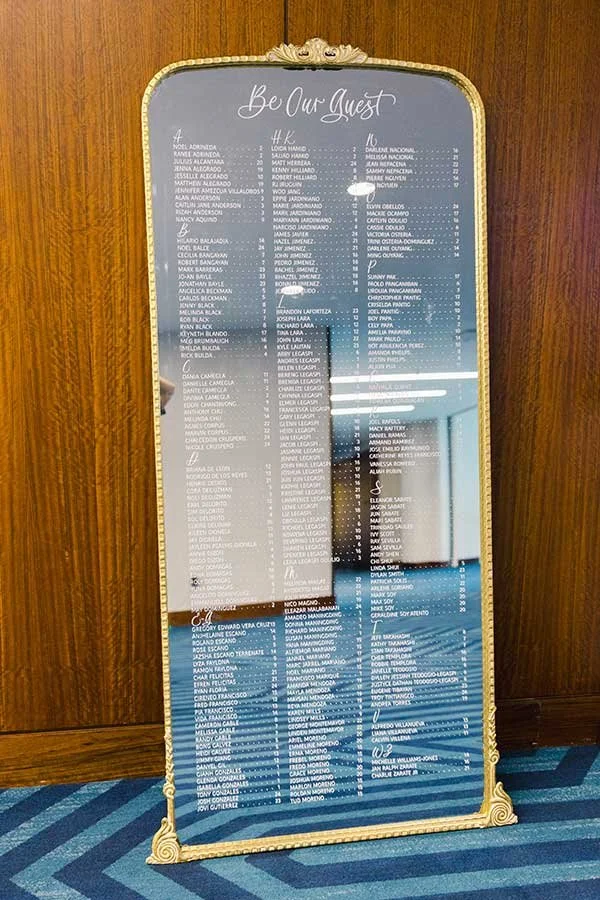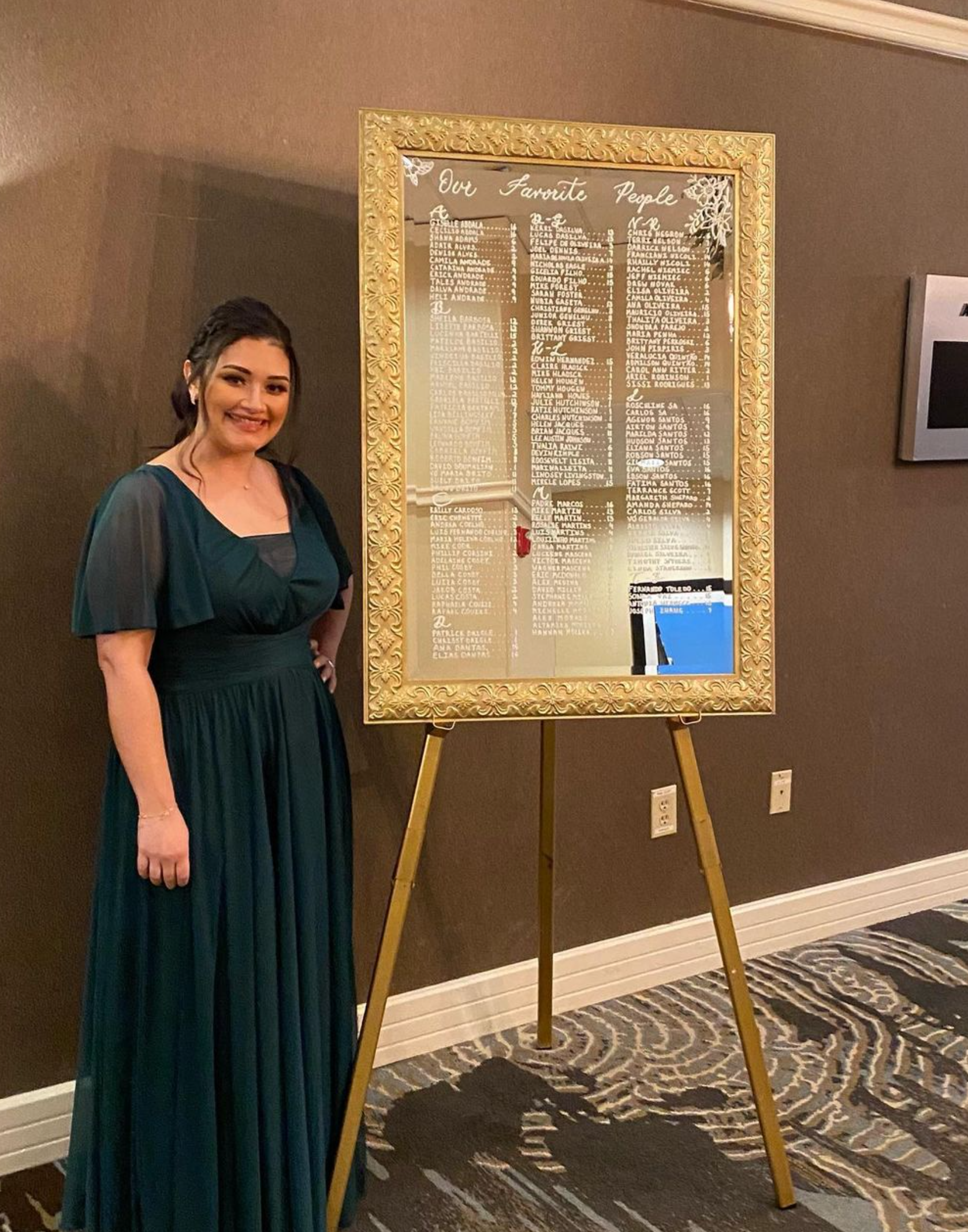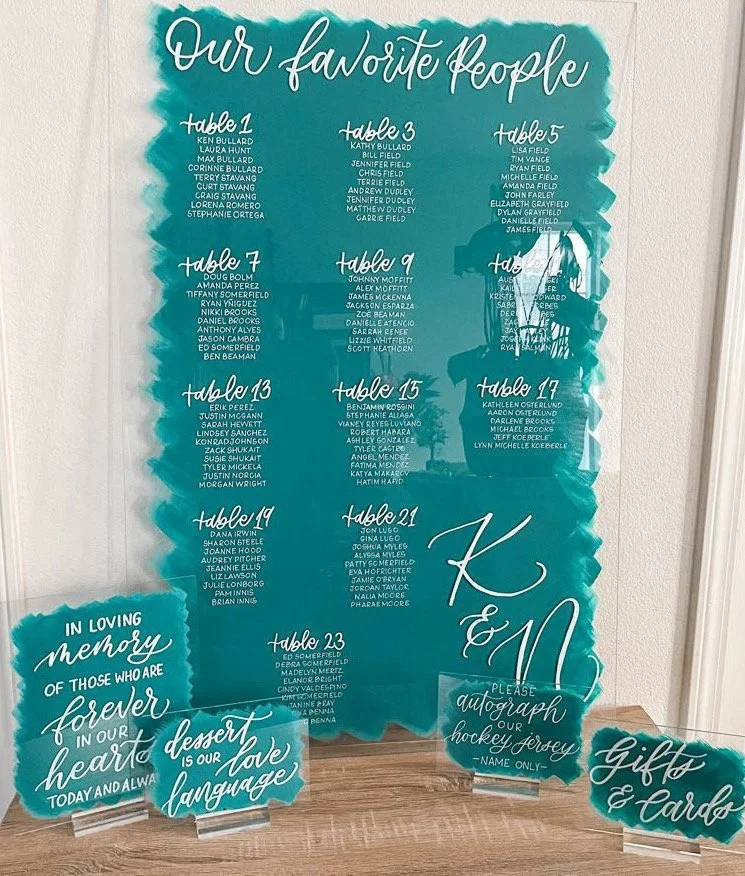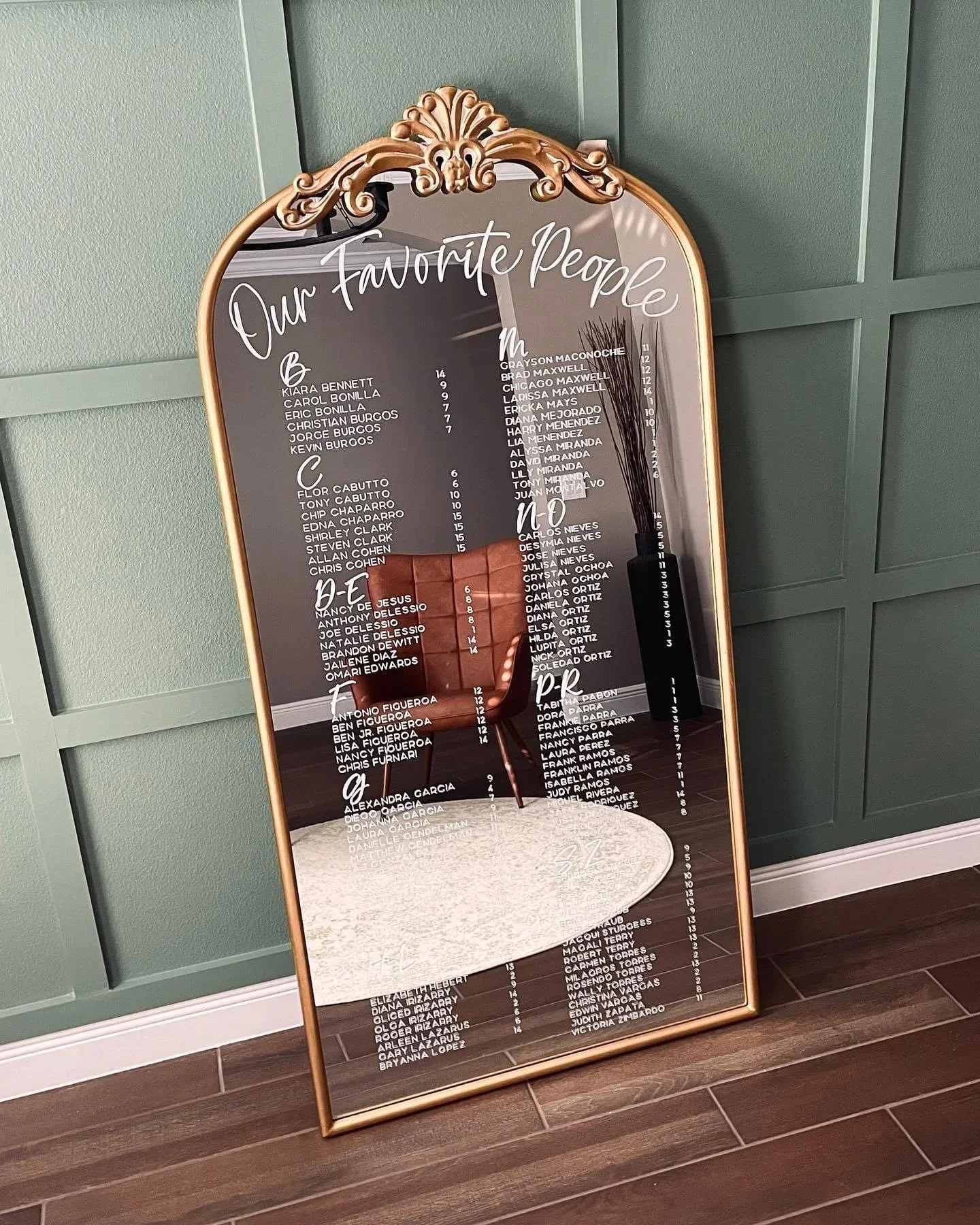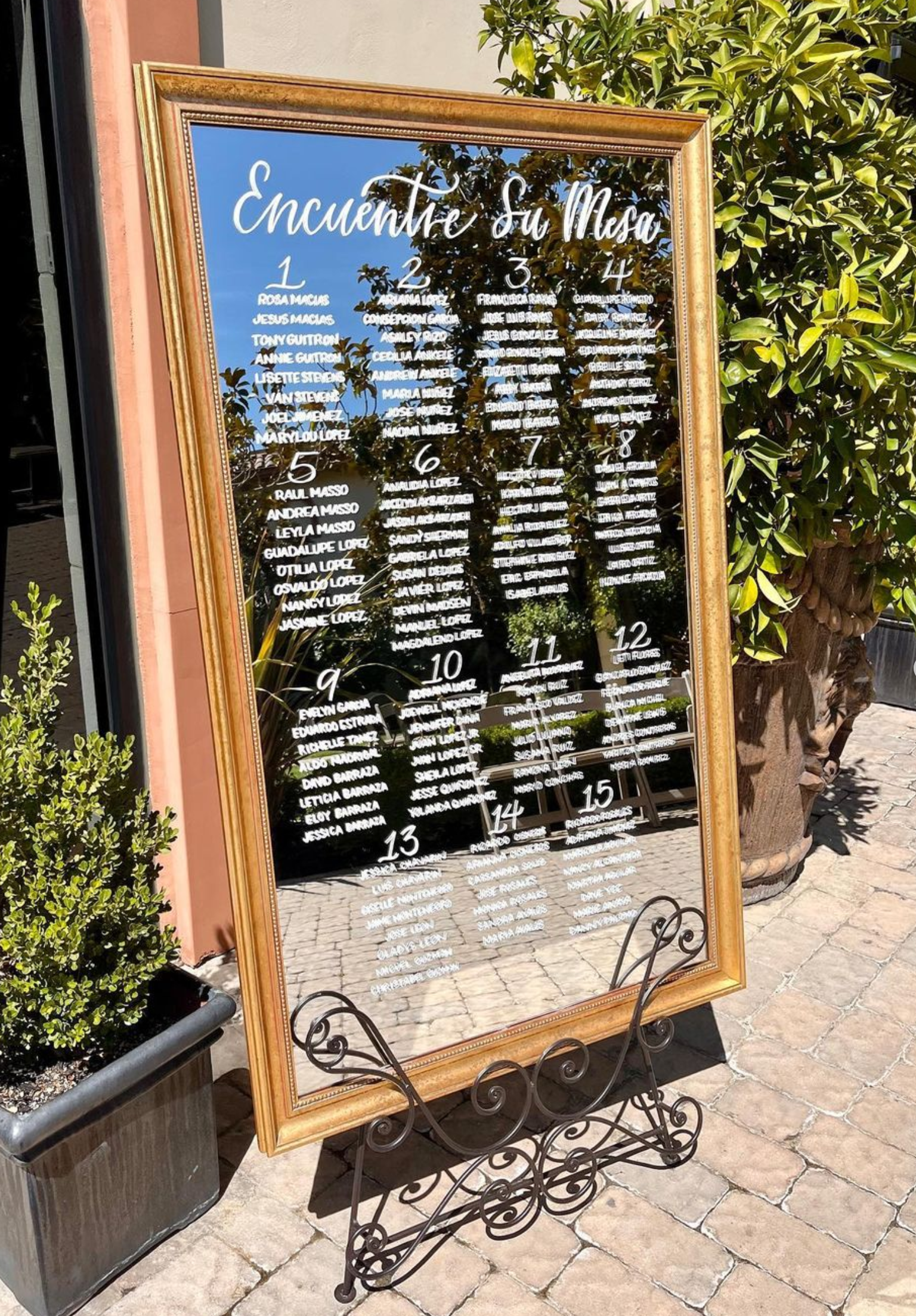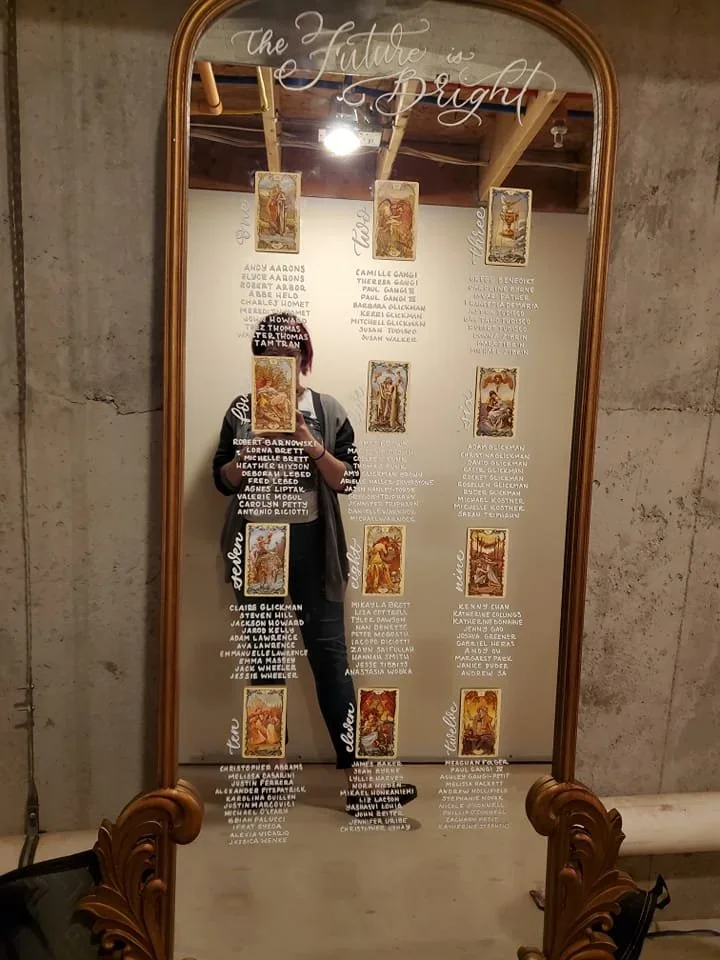How To Plan, Price, And Make Calligraphy Seating Charts
Seating charts are one of the most detailed and lucrative services that calligraphers can offer. They’re precise, customized for each event, and allow you to get creative — whether that means working with mirrors, acrylic, wood, or something completely unexpected. More than smaller signage, like table numbers or bar signs, seating charts require a blend of technical planning (aka, math and measurements!), client communication, and creative design. That’s why they’re treated as a premium service, and why clients actively seek out artists who specialize in them.
Adding seating charts to your calligraphy offerings naturally increases your order size, especially when paired with matching signage and stationery details. Even smaller seating charts often start around $400–800, with more elaborate installations regularly reaching $3,000+, making this one of the highest-value services in a calligrapher’s offerings. Some calligraphers eventually make seating charts such a consistent source of income that it becomes the foundation of their business.
Whether you’re a calligrapher who’s just booked your first seating chart client, a seasoned creative expanding into signage, a DIYer tackling your own wedding, or a lettering artist hoping to add seating charts to your services — this blog will walk you through what actually goes into a successful seating chart so you can offer it confidently and build from there.
Photo by Function and Flourish
Special Discount: 20% off my Seating Chart Course
If you're ready to take on seating charts with confidence — from quoting and client intake to layout, math, and real-world logistics — my Seating Chart Success course is for you! I’ll walk you through the entire process to plan, design, and create beautiful seating charts, step by step. You’ll get access to the Seating Chart Calculator I created to take the stress (and math) out of spacing and layout, so you can spend less time crunching numbers and more time creating. Perfect for calligraphers and DIY couples! Get 20% off the course with code SCS20 for reading this blog!
What Is a Seating Chart?
Seating charts are a way to show guests where they’re sitting at a wedding, party, or corporate event. Some charts are minimalist and elegant, like a seating chart mirror. Others are large-scale installations, like an escort wall made up of individual name cards, jars, display elements - and sometimes lighting! Whatever the format, seating charts are not just pretty signs — they’re functional pieces of art, and often statement pieces, that help an event flow smoothly and keep guests from wandering around in confusion.
I mean, can you imagine a wedding with no seating chart? Pure chaos! My average wedding clients have between 100–150 guests. Without any direction, that’s a lot of people shuffling around, unsure of where to go. It’s a logistical nightmare for planners, brides, and hosts, and a major stressor for guests. That’s why a seating chart isn’t optional — it’s essential! And when you design one with intention, you’re solving a very real problem in a way that’s beautiful, personal, and entirely custom.
Pro Tip: Individual escort cards can serve the purpose of helping guests find their seat, too, but functionally, especially for larger weddings, it's easier for guests to find their names on a standing board display than it is to sort through 100+ individual cards on a table. Another reason why your planning and design expertise are so impactful to the flow of the event!
Why Calligraphers Should Offer Seating Charts
Seating charts aren’t just a beautiful upgrade to your services — they’re a smart business decision! They naturally increase the size and value of each project, especially when clients also need matching place cards, welcome signs, or bar menus.
They’re also a great way to bring more creativity into your business. Planning, designing, and playing with different mediums gives you the chance to showcase your style and bring your clients’ vision to life. One weekend, you might be writing on a gold-framed mirror, and the next, you're building an escort wall with mini tequila bottles or garden boxes. The layout possibilities are endless — especially when you start offering your own ideas, not just the Pinterest go-tos.
Like I said before, some calligraphers have built their entire business around seating charts. Once you’ve developed a smooth process for quoting, planning, and producing them, they become a repeatable, high-value service that clients appreciate and need. If you’re looking to expand your offerings or boost your income, seating charts are a smart place to start.
How to Make a Seating Chart (The Hidden Math behind Calligraphy Signage)
Once you’ve booked a seating chart, the first step isn’t writing—it’s logistics. Before you can even begin designing a seating chart, you need to translate a raw guest list into a functional layout.
That means knowing things like:
How many names you're working with
How much physical space you have
Whether florals will block part of your canvas and impact your margins
Whether it’s best to list names by table or in alphabetical order
How big to write the names and headings
How many columns will fit on the sign without cramping the spacing, and how many lines per column before you run into the edge of the board
And the list goes on…
Most people don’t realize the amount of logistics and sheer math behind something that looks so simple. But if you’ve ever tried to sketch out a layout by hand, you already know — spacing issues snowball fast. You know the saying, “measure twice, cut once?” The same idea applies here, and it’s so important to get the layout and design right before starting to write!
Logistics are the biggest reason why calligraphers hesitate to offer seating charts. One extra name or longer line of text can throw off the entire balance of a design. That’s why you can’t just eyeball it. You need a system that lets you work backwards from the display size and guest count to build a layout that actually works.
When I first started making my own seating charts, I did this manually using graph paper, spacing guesses, and a lot of trial and error. It took forever. Now, I use my Seating Chart Calculator to plug in guest count, column preferences, and layout orientation, and it handles the math for me! Whether you’re organizing names by table or by last name, the calculator helps you adjust the number of lines, columns, and margins automatically without having to recalculate every time something changes. And you will have changes! If one name shifts or a guest RSVPs late, or someone asks to bring a plus one, the whole layout can shift — unless you have a system that updates it for you.
That’s why layout planning and the quick calculator are a core part of my Seating Chart Success Course, because once you know how to map it out properly, you can easily cut the time it takes you to create a seating chart in half. One of my students even told me that the course saved her 24 hours of work!
Ideas for Creative Seating Charts
One of the best parts about offering seating charts is how customizable they are. You’re not limited to a mirror or single surface — in fact, the more creative your medium, the more attention the signage gets. The right materials can turn your seating chart into a statement installation, something guests take photos of and talk about long after the last toast.
Photo by Jasmine Lee Photo
Wedding Seating Chart Mirrors
Mirror seating charts are classic, elegant, and always on trend. Mirrors are a favorite for couples who want something timeless, and they work well in nearly any venue. Due to their fragile nature, I recommend setting up mirrors indoors and making sure they are well supported against a wall or a low easel.
Acrylic Seating Charts
Sleek and modern, acrylic is one of the most versatile surfaces to work with. You can keep it clean and minimalist with white ink, use frosted acrylic, or paint the back for added depth. These are especially great for outdoor or contemporary venues.
New To Writing On Acrylic?
Start with my Acrylic Sign Starter Kit for Calligraphers, with everything you need to learn to write on acrylic signs! It comes with 10 acrylic blanks, pre-cut to common signage sizes, my favorite pen for lettering on acrylic, and tabletop stands to display your work so you can get photos for your portfolio.
Photo by C. Wagner Photography
Wood Seating Charts
Wood brings warmth and texture to your design. It’s especially popular for rustic or boho weddings, and works beautifully with white ink. Keep in mind that wood grain and stain color can affect legibility, so always test your materials before you commit.
Escort Walls with Cards or Tags
Instead of one large sign, escort walls are a creative way to help guests find their names on individual cards, envelopes, or objects. These can be pinned to a wall, strung up with ribbon, or displayed in creative installations, like on shelves or in vases. Escort walls are perfect when the couple wants the seating display to double as a favor or decorative feature.
Unexpected Surfaces
Glass jars, tiles, acrylic cubes — if it has a smooth enough surface, it can probably be lettered. These are the seating charts that go viral and live on in portfolios. If you have a wild idea, test it, style it, and shoot it — even if it’s just for you. Clients often say yes to what they’ve already seen in your feed, and expanding into fun, unique mediums can increase your bookings.
Photo by Maliah Monica
Ready to Offer Calligraphy Seating Charts in Your Business?
Seating charts don’t have to be intimidating — but they do need structure, planning, and a clear process behind them. If you’ve sold one already (or want to), it’s worth having a system that helps you streamline the challenging parts.
As a blog reader, you can take 20% off my Seating Chart Success course with code SCS20 at checkout! I’ll walk you through everything from layout and design to pricing, and production — plus, you’ll get access to my Seating Chart Calculator to take the math off your plate.
Take a look at just some of the seating charts that my students have created with help from the course!
Many of these are their first ones!



